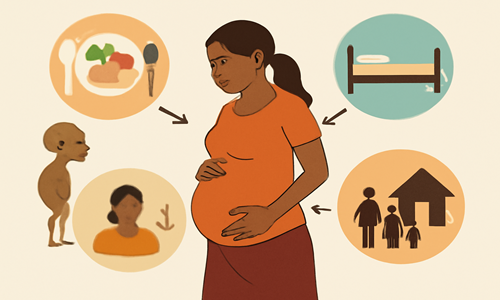Determinants of chronic energy deficiency (CED) in pregnant women in stunting
Abstract
Introduction: Chronic Energy Deficiency (CED) in pregnant women is a condition resulting from prolonged malnutrition, particularly insufficient energy and protein intake. This condition significantly increases the risk of maternal and infant mortality, low birth weight (LBW), and contributes to stunting in children. This study aims to identify the determinants influencing the incidence of CED among pregnant women in the stunting.
Method: A cross-sectional observational study was conducted among 201 pregnant women selected through purposive sampling from 30 stunting-prone villages. Data collection involved Android-based questionnaires and anthropometric measurements using Mid-Upper Arm Circumference (MUAC). Statistical analyses included chi-square tests for bivariate analysis and logistic regression for multivariate analysis.
Results: The prevalence of CED among the participants was 15.9%. Significant factors associated with CED included maternal age (p=0.000; OR=2.79; 95% CI: 1.67–4.64), employment status (p=0.016; OR=6.73; 95% CI: 1.58–27.94), antenatal care visits (p=0.004; OR=11.31; 95% CI: 2.71–28.19), pregnancy spacing (p=0.023; OR=6.80; 95% CI: 1.31–26.8), family smoking history (p=0.002; OR=0.45; 95% CI: 0.27–0.75), and family income (p=0.013; OR=5.24; 95% CI: 1.73–26.02).
Conclusion: CED among pregnant women is significantly influenced by age, occupational status, antenatal care frequency, pregnancy interval, family exposure to cigarette smoke, and low household income. Strengthening antenatal care services, promoting family planning, enhancing nutrition education, and mitigating environmental risk factors such as secondhand smoke exposure are essential strategies to reduce CED and its adverse health outcomes.
Downloads
References
Abadi, E. and Putri, L. A. R. (2020) ‘Nutrition Assistance Increases The Size Of Middle-Upper Arm Circumference Of Pregnant Women With Chronic Energy Deficiency’, Public Health of Indonesia, 6(4), pp. 157–162. doi: https://doi.org/10.36685/phi.v6i4.354.
Akib, A. and Rukinah, R. (2024) ‘Effect of anemia in pregnant women on the incidence of premature labor and low birth weight’, Jurnal Ilmiah Kesehatan Sandi Husada, 13(2), pp. 427–433. doi: https://doi.org/10.35816/jiskh.v13i2.1241.
Anggriani Harahap, D. et al. (2025) ‘Chronic Energy Deficiency and Its Associated Factors among Pregnant Women Living in Rural Areas, Indonesia: A Community Based Study’, Jurnal Kesehatan Manarang, 11(1), pp. 118–124. doi: https://doi.org/10.33490/jkm.v11i1.1982.
Arda, D., Lalla, N. N. L. N. and Suprapto, S. (2023) ‘Analysis of the Effect of Malnutrition Status on Toddlers’, Jurnal Ilmiah Kesehatan Sandi Husada, 12(1), pp. 111–116. doi: https://doi.org/10.35816/jiskh.v12i1.910.
Arnianti, A., Adeliana, A. and Hasnitang, H. (2022) ‘Analisis Faktor Risiko Anemia dalam Kehamilan pada Masa Pandemi Covid-19’, Jurnal Ilmiah Kesehatan Sandi Husada, 11(2 SE-Articles), pp. 437–444. doi: https://doi.org/10.35816/jiskh.v11i2.807.
Astuti, D. D., Handayani, T. W. and Astuti, D. P. (2020) ‘Cigarette smoke exposure and increased risks of stunting among under-five children’, Clinical Epidemiology and Global Health, 8(3), pp. 943–948. doi: https://doi.org/10.1016/j.cegh.2020.02.029.
Bell, Z. et al. (2024) ‘Associations between food insecurity in high-income countries and pregnancy outcomes: A systematic review and meta-analysis’, PLOS Medicine, 21(9), p. e1004450. doi: https://doi.org/10.1371/journal.pmed.1004450.
Hariram, N. P. et al. (2023) ‘Sustainalism: An Integrated Socio-Economic-Environmental Model to Address Sustainable Development and Sustainability’, Sustainability, 15(13), p. 10682. doi: https://doi.org/10.3390/su151310682.
Keats, E. C. et al. (2021) ‘Effective interventions to address maternal and child malnutrition: an update of the evidence’, The Lancet Child & Adolescent Health, 5(5), pp. 367–384. doi: https://doi.org/10.1016/S2352-4642(20)30274-1.
Kelly, A. C., Powell, T. L. and Jansson, T. (2020) ‘Placental function in maternal obesity’, Clinical Science, 134(8), pp. 961–984. doi: https://doi.org/10.1042/CS20190266.
Marshall, N. E. et al. (2022) ‘The importance of nutrition in pregnancy and lactation: lifelong consequences’, American Journal of Obstetrics and Gynecology, 226(5), pp. 607–632. doi: https://doi.org/10.1016/j.ajog.2021.12.035.
Matenchuk, B. A. et al. (2023) ‘Emergency Department Visits During Pregnancy’, Annals of Emergency Medicine, 81(2), pp. 197–208. doi: https://doi.org/10.1016/j.annemergmed.2022.06.021.
Muchlis, N. et al. (2023) ‘Cigarette Smoke Exposure and Stunting Among Under-five Children in Rural and Poor Families in Indonesia’, Environmental Health Insights, 17, p. 11786302231185210. doi: https://doi.org/10.1177/11786302231185210.
Nasaru, J. et al. (2024) ‘Factors Associated with Chronic Energy Deficiency (CED) in Pregnant Women: A Study in North Gorontalo Regency, 2023’, BIO Web of Conferences. Edited by M. I. Kartasurya et al., 133, p. 00003. doi: https://doi.org/10.1051/bioconf/202413300003.
Ningtyias, F. W., Jamil, A. I. and Antika, R. B. (2024) ‘Konsumsi Makan dan Tingkat Pendapatan Keluarga dengan Kejadian Kekurangan Energi Kronik Pada Ibu Hamil di Wilayah Pesisir di Indonesia: Tinjauan Pustaka Sistematis’, Amerta Nutrition, 8(4), pp. 675–685. doi: https://doi.org/10.20473/amnt.v8i4.2024.675-685.
Parrettini, S., Caroli, A. and Torlone, E. (2020) ‘Nutrition and Metabolic Adaptations in Physiological and Complicated Pregnancy: Focus on Obesity and Gestational Diabetes’, Frontiers in Endocrinology, 11, p. 611929. doi: https://doi.org/10.3389/fendo.2020.611929.
Prasetyo, Y. B., Permatasari, P. and Susanti, H. D. (2023) ‘The effect of mothers’ nutritional education and knowledge on children’s nutritional status: a systematic review’, International Journal of Child Care and Education Policy, 17(1), p. 11. doi: https://doi.org/10.1186/s40723-023-00114-7.
Rachmi, R. et al. (2024) ‘Factors Affecting Chronic Energy Deficiency among Pregnant Women in East Nusa Tenggara Province, Indonesia’, Jurnal Gizi dan Pangan, 19(Supp.1), pp. 95–104. doi: https://doi.org/10.25182/jgp.2024.19.Supp.1.95-104.
Shi, H. et al. (2022) ‘Severity of Anemia During Pregnancy and Adverse Maternal and Fetal Outcomes’, JAMA Network Open, 5(2), p. e2147046. doi: https://doi.org/10.1001/jamanetworkopen.2021.47046.
Usi Lanita, Sri Astuti Siregar and Kasyani Kasyani (2024) ‘The Relationship between Pregnancy Spacing and Parity with Incidence of Chronic Energy Deficiency (CED) in Pregnant Women’, The International Science of Health Journal, 2(4), pp. 144–150. doi: https://doi.org/10.59680/ishel.v2i4.1626.
Wati, Erna K. et al. (2024) ‘Determinants of chronic energy deficiency (CED) incidence in pregnant women: A cross-sectional study in Banyumas, Indonesia’, Narra J, 4(1), p. e742. doi: https://doi.org/10.52225/narra.v4i1.742.
Wells, J. C. K. et al. (2021) ‘The future of human malnutrition: rebalancing agency for better nutritional health’, Globalization and Health, 17(1), p. 119. doi: https://doi.org/10.1186/s12992-021-00767-4.

Copyright (c) 2025 Irma Irma, Sugirah Nour Rahman, Hasra Ryska, Veny Hadju

This work is licensed under a Creative Commons Attribution 4.0 International License.




2.png)
1.png)
1.png)










